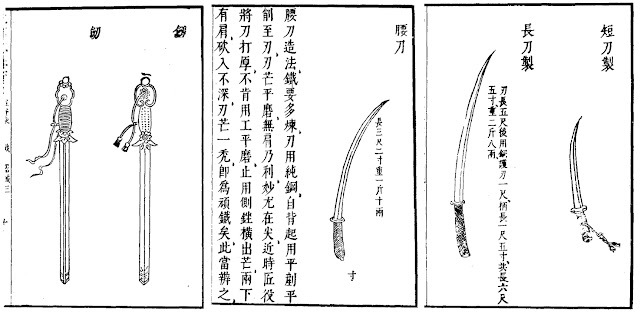 |
| Drawings of various types of Ming Dynasty swords and sabres. From left to right: Two Jian, a Yao Dao, a Chang Dao, and a Duan Dao. From 'Wu Bei Zhi (《武備志》)'. |
Classification of Chinese swords often posed a great challenge to Westerners (and just as confusing to the Chinese themselves) because Chinese swords do not fit readily into existing typologies. The Chinese also lacked an authoritative, systematic typology of sword types such as that of the Oakeshott typology.
This blog post is intended to be an introductory article to the swords and sabres of the Ming Dynasty. Please note that the terms used here are what we call "collector's jargon" (i.e. classification used by sword collectors and antique sellers). They are not historical terms*, and are not meant to be academically authoritative (although most Chinese academics do follow the classification).
Historical terms for one-handed Chinese sabre are Yao Dao (腰刀), Duan Dao (短刀, short sabre), Gun Dao (滾刀, lit. 'Rolling sabre', exact meaning unknown), Shou Dao (手刀, lit 'Hand sabre') and Ma Dao (馬刀, cavalry sabre). All of these terms are generic.
This blog post is intended to be an introductory article to the swords and sabres of the Ming Dynasty. Please note that the terms used here are what we call "collector's jargon" (i.e. classification used by sword collectors and antique sellers). They are not historical terms*, and are not meant to be academically authoritative (although most Chinese academics do follow the classification).
Historical terms for one-handed Chinese sabre are Yao Dao (腰刀), Duan Dao (短刀, short sabre), Gun Dao (滾刀, lit. 'Rolling sabre', exact meaning unknown), Shou Dao (手刀, lit 'Hand sabre') and Ma Dao (馬刀, cavalry sabre). All of these terms are generic.
 |
| Extant Ming Dynasty Yan Ling Dao |
Yan Ling Dao is commonly known as "yanmaodao" in the West (not to say they are wrong, but this does deviate from the definition agreed upon by Chinese collectors. On top of that, Yan Ling Dao is a historical term while Yan Mao Dao isn't).
Yan Mao Dao (雁毛刀, lit. 'Goose feather sabre')
 |
| Extant mid Qing Dynasty Yan Mao Dao. Note the rounder point (Click to enlarge). |
Liu Ye Dao (柳葉刀, lit. 'Willow leaf sabre')
 |
| A short Liu Ye Dao. Note the gentle curvature of the blade. |
It is commonly believed that curved sabre, based on Central Asian prototypes, was introduced to China in the wake of Mongol conquest. In actual fact, warriors of Khitan Liao Dynasty and Jurchen Jin Dynasty were using curved sabres nearly identical to Ming and Qing sabres centuries before the rise of the Mongols, although the Mongol conquest did help to spread the popularity of curved sabre to the rest of China.
Qi Jia Dao (戚家刀, lit. 'Sabre of House Qi')
 |
| A Qi Jia Dao. Private collection. |
Other names for this type of sabre are Wo Yao Dao (倭腰刀, lit. 'Japanese waist sabre'), Wo Shi Yao Dao (倭式腰刀, lit. 'Japanese-style waist sabre') and Fang Wo Dao (仿倭刀, lit 'Imitation Japanese sabre'). It should not be confused with Chang Dao (長刀), which is a very large two-handed sword.
For those interested, here is a very good article on this specific kind of sabre: Woyaodao: Chinese saber of Japanese style
Yan Chi Dao (雁翅刀, lit. 'Goose wing sabre')
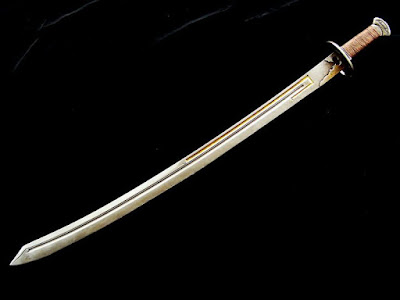 |
| Extant mid to late Qing Dynasty Yan Chi Dao. |
Yu Tou Dao (魚頭刀, lit. 'Fish head sabre')
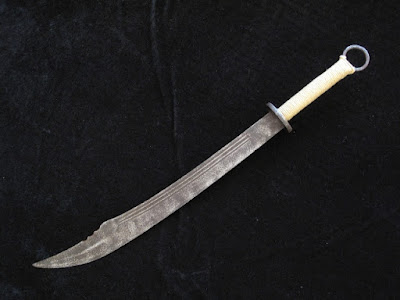 |
| Extant late Qing Dynasty Yu Tou Dao. |
Zhi Dao (直刀, backsword)
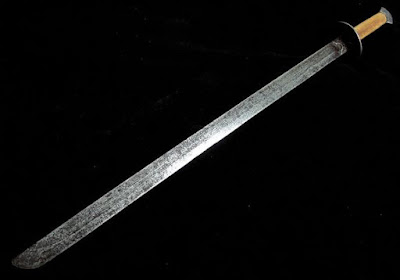 |
| Extant Ming Dynasty Zhi Dao that is reminiscent of Tibetan dpa'dam and Bhutanese patag. |
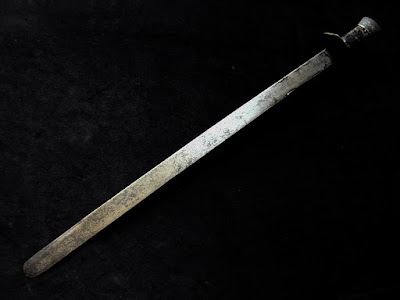 |
| Extant Ming Dynasty Zhi Dao that is almost indistinguishable from a double-edged jian. |
Jian (劍, double-edged sword)
 |
| Extant mid Ming Dynasty jian. This sword has a blade length of 32 inches and hilt length of 7 inches. |
Note: After careful consideration, I omitted the entries for Niu Wei Dao (牛尾刀, lit. 'Oxtail sabre'), Pian Dao (㓲刀) and Shun Dao (順刀), which were developed during the Qing period, thus fall outside the scope of this article. I also omitted the entries of Gui Tou Dao (鬼頭刀, lit. 'Ghost/Demon head sabre'), Yun Tou Dao (雲頭刀, lit. 'Cloud head sabre') and Er Tou Dao (鵝頭刀, lit. 'Goose head sabre') which are extremely uncommon.
Further Reading
Peter Dekker from Mandarin Mansion has written an extremely comprehensive article on the typology of Chinese sabre. In my opinion his typology should hereby be used as the standard typology from now on. Link below:a Chinese saber typology
Note that there's a slight difference between us on the interpretation of Yan Ling Dao and Yan Mao Dao. Mr. Peter's interpretation reflected the consensus among Western collectors, while my interpretation, borrowed heavily from a well-researched collector's reference book known as 《刀兵相见:近五百年中国战场轻兵器》, reflected the consensus among Chinese collectors.
Is there a particular purpose to rounded tips on swords, or is it just to make use of a damaged blade? Otherwise it seems a bit odd to forgo the thrusting ability?
ReplyDeleteThe broad spatulate point allows very effective cuts to be delivered with the very tip of your sword - hence extending the cutting reach of your sword. Acute tipped swords do not cut very well near their tips, so despite the same lenght of blade your effective cutting distance is less.
DeleteAgainst flesh and blood and textille a sharp spatulate point can penetrate quite well in the thrust - and cause wider and hence potentially more debilitating wounds too! An acute point is only useful if you have to penetrate a lot of resistive material like mail. Thus a study of European sword designs showed that spatulate points were very popular all the way to the middle of the 14th century, when plate armor started coming into fore and henceforward an acute point was needed to defeat the mail in the gaps of that armor.
In China armor design never quite reach this level of sophistication, likely due to the prevalence of mass conscript armies equipped with mass produced equipment rather than small numbers of warriors arming themselves out of their own pockets. Hence most combatants in Chinese warfare had plenty of unarmored body parts that a sharp sword can dismember, and so cutting oriented blades should be very popular indeed.
There are various tip shapes of Chinese swords, from acute, tapper, triangle, oval, flat to round shape, I've seen at least 5 or 6 different kinds of tip shapes, not just round shape.
DeleteTo say some Chinese swords had round tip merely because Chinese didn't use mail and plate armor or "never" had sophisticated armor designs is not only misleading but also completely false. Chinese army did equip heavy armor, especially during Song dynasty which was the prime days of heavy infantry, Ming dynasty military also deployed heavy infantry, they also had plate-mail armor(板鍊甲), not just lamellar or brigandine or fabrics.
To break through metal armors, regardless plate, mail, lamellar...etc, the best way is always to use projectile weapons like bows and firearms or blunt weapons such as mace, warhammer, heavy axe, not swords, doesn't matter it's in Western or Eastern cultures, and Chinese military did utilize many projectiles and blunt weapons, the most common ones were mace(錘) and "Bian/Jian(鞭/鐧)", you can also find articles of them on this very website.
DeleteAcute swords maybe can stick though mail but not really lamellar and brigandine, most of all, no swords can really break through plate armor, I've seen many test videos, swords simply cannot do it and is not design to do so. If you just like using swords to hit plate armors, your swords could be damaged first before the armor is broken.
Over like the least year I there have been some records I heard of using mail in the Ming dynasty. Even an armoury report but stating that ther were only like 200 mail shirt in the I believe it was the capitola armory mong some other 10000 armor seets.
DeleteWe get records of mail armors being used throughout the Tang and Qing periods as well.
DeleteRegarding sword points optimized for armor rich environments, blade styles commonly seen on so-called "Hanjun" sabres and other Southern Chinese single edged swords (whether it be military sabres or butterfly swords) have blades that show strong profile taper very much akin to several late medieval European sword blade typologies. A large number of non-Southern Chinese dao sport decently pointed tip designs as well.
Sword blade types such as Qijiadao & Liuyedao also benefit from having their point positioned at their thick spines, which in a way ends up bringing similar benefits to rondell daggers. Certain Liuyedao and other sabre designs instead have tip designs that are more spear-tip like in characteristics.
As for jian pointed tips of varying degrees were in use since the Han/Chu period all the way through the late Qing.
The drop point can thrust reasonably well too (it resemble the tip of a double-edged sword after all), but it is more of a "general purpose" design.
ReplyDeletehttp://www.knife-depot.com/knife-information-105.html
The design consideration of modern survival knife might shed some insight into the design of Yan Mao Dao.
As for why damaged Yan Ling Dao are modified into Yan Mao Dao, that is because for most Chinese sword, only the edge are made of steel, while rest of the sword iron. When the steel tip of a Yan Ling Dao broke off, it lose its thrusting edge forever - even if it is restored back to Yan Ling Dao shape, the exposed iron part cannot thrust as well as the original steel tip, not to mention it is susceptible to further damage.
What can you tell me of the yuntoudao? I have an interest in it and can find nothing on it.
ReplyDelete@Christopher Godby
ReplyDeleteGood day and welcome to my blog.
Yuntoudao is...superficially similar to an upturned Nepalese Kora sword. Sometimes authentic Kora swords (Qing court sometimes receive these as gifts or tributes) are labelled as Yuntoudao as well.
What do you mean when you said the Jian simply dissapeared from the battlefield? Is there a reason why many stereotypical Qing warriors carry Dao type instead of Jian?
ReplyDeleteDao was by far a much more common weapon on the battlefield, but Jian was not completely phased out either.
DeleteBut, do you know why? Was it because Jian was associated with the higher class? Maybe, the Dao was easier to use and more straightforward?
DeleteTo be honest, I have no idea. If I have to hazard a guess, I would say cultural preference and/or influence of nomadic cavalry tactics.
DeleteMany cultures over the east side of the globe preferred single-edged slashing swords over double-edged ones, and many of them also employed horse archers and composite bows. These two may or may not go hand in hand together.
Jian was being "phased out" ever since the invention of Ring-Pommel sabre/backsword in West Han dynasty. From than on double-edge Jians were not common battlefield weapons.
DeleteRing-Pommel Sabre was invented during the war with the nomadic Xiongnu, so we can hypothesise that it was a better cavalry weapon. At the same time, it can be argued that it is easier to make and maintain due to having only one edge and the blade geometry allows different types of weight distribution and blade shapes for specific purpose.
I also like to think this type of backsword is better at dealing with lamellar armour since it puts more weight on the back to produce a heavier blunt force tremor.
If we take into account that ancient sword making could only place steel on the edge due to technological limitations, then backsword is definitely more economical.
DeleteDuly noted and considered. Thanks for the input!
DeleteI happened to notice not a lot of these sabers have Tunkou 吞口 or "Blade Collar". Could the earlier Mongol Sabers have had an influence on that as well? I haven't seen any of them with Tunkou either. Yet almost every Liuyedao I see has one (especially ones from the Qing Dynasty). I don't get it. Or maybe the Tunkou was just a decorative trend item and I'm just overestimating its importance.
ReplyDeleteAlso as a side note, maybe the term Gun Dao 滾刀 is referring to 滾珠刀 Gun Zhu Dao (lit. rolling pearl saber) with the small steel or brass "pearl" that rolls around inside of the blade fullers/grooves. Just a thought.
I don't recall seeing Tunkou on Mongol sabres (then again, I know very little about Mongol sabre), but Tunkou was present on Chinese swords as early as Five Dynasties period (and possibly even earlier. I just did a quick Google, not researching in detail). Some say it is useful to let the sword fits more tightly with its scabbards, while others say it is purely decorative.
Delete滾刀 and 滾珠刀's connection is plausible, although we need further evidences. Ming texts also mention Japanese and polearm version of 滾刀, is installing rolling pearls on polearm a common practice?
I have a question. I have been doing a little research and have been looking at General Yu Dayou's (俞大猷) treatise Jianjing (剑经) In the text Yu Dayou uses a staff to illustrate the concepts of using a sword, however, I want to know what kind of sword the general himself most often used. I have looked around on Baidu and there is a reference to a long sword of Jingchu (荆楚长剑). I am unfamiliar with what exactly a Ming dynasty long sword should be like. Is it a two handed jian? about how long would the sword be? If you had any information on this it would be greatly appreciated. Thanks.
ReplyDeleteYu Dayou's Swrod Manual actually teaches the core principles of armed combat, and can be adapted to every close combat weapon out there. It is said that the teaching of Jingchu longsword is also included inside Sword Manual (certainly isn't far fetched, as Jingchu was repeatedly mentioned in the manual), although as of now no one actually tried to reconstruct a complete system based on Sword Manual. Yu Dayou himself probably used quarterstaff, spear, and bow.
DeleteSorry I don't have any new info on Ming period two-handed Jian.
The name of Yu's Sword Manual (劍經) is such a mystery. The weirdest thing is that the word "sword" as in the actual sword isn't mentioned once within the manual; the word "quarterstaff" (棍) is used instead every time.
DeleteMy guess is that the "Long Sword of Chu" (荊楚長劍), is just simply the name of his quarterstaff school, and we shouldn't read too much into that. Of course, we can't know for sure.
As to the question of double-handed sword, Wubeizhi's (武備誌) author suggested that there was none, neither double-handed nor single-handed, at least not in official military use other than ceremonial. He did attach Korean Jian(劍) techniques to his treatise, but from what we can see, it was not a proper double-handed sword.
There was, however, double-handed long sabre, a la Miao dao, a la Japanese long sword.
There's some research articles that I've read that argue that Jian Jing does indeed contains many elements of swordsmanship, as it contains many techniques that is not normally found in quarterstaff martial arts.
DeleteMany thanks if you could link the articles. But facts remain that Yu was talking directly and primarily about quarterstaff, not any bladed weapon, while it could be true that he did incorporate other techniques into his quarterstaff.
DeleteThe article is named 《劍經研究》, written by 張銀行, specifically page 4~5 of the pdf file. It is available freely online here:
Deletehttp://www.cisszgty.com:85/v2/article.do?op=download&id=1688
The author points out that MOST techniques in Jian Jing are thrusts, point-cuts/quick thrusts (點) and slices, which are characteristics of edged weapons.
Hi!
ReplyDeleteI came here to ask if you have any info on the metallurgy and heat treatment of Chinese swords. Were they spring tempered or were they differentialy hardened like Japanese swords? And also did they use laminated construction or mono-steel blade? Thanks!
Ming swords are usually made by sandwiching a hard steel (including edge) between two softer steels - somewhat similar to Japanese sanmai lamination, or inserting a hard steel edge into a softer steel blade.
DeleteObviously, that's laminated construction. They also used differential hardening.
Some of the more famous steel patterns of Chinese sword are "twisted core" pattern and "horse tooth" pattern.
Thank you that's really informative!
DeleteMay I ask you if they used more flexible swords (spring tempered) or differentially hardened ones?
Also, I'm not familiar at all with Chinese sword making, but did they fold the steel? As far as I'm aware they used blast furnaces to produce steel but I'm curious if they actually used this technique to create decorative patterns. Anyway thank you for answering!
They also preferred stiffer, differential hardened sword.
DeleteYes, the folded their steel too.
Hey wanted to ask did the Chinese use dual wielding on the battlefield and what's the earliest account of dual wielding in China.
ReplyDeleteOn an unrelated note, I got into a long drawn-out argument with somebody I'm not going to go through it all but would you say Tang merely succeeded and adopted tactics used by the Han and that there was no advancements in weaponry since it was pretty peaceful, I'm no expert but wasn't it dynasties like the Sui that Tang got more from.
Yes. It's not very common, but they did dual wield on the battlefield. I can't recall what is the earliest account of it though.
DeleteI am no expert on Tang history, although I think the empire that destroyed Gorguyeo, Bakje, both Eastern and Western Turkic Khaganate, fought the Tibetan Empire and Nanzhao Kingdom, and had to deal with several large scale rebellions would be anything but peaceful.
Also, given the prevalence of Turkic troops among Tang army, I will be surprised if they didn't learn anything from them. For weaponry, armour did advance quite a bit, but sword and spear would remain sword and spear.
Thanks, well what is the earliest record of dual wielding that you know of, everything I found about dual wielding are butterfly swords or hook swords only.
DeleteAgain thanks wish I remember some of that information during the argument I had.
By the way can you give me some information regarding the unarmor martial art the Chinese military learn throughout the dynasties and also what exactly is Chin Na.
To the extend that I can remember, Qi Ji Guang dual wielded jian in battle, and there's one dude wielding two dao in the painting Wakō-zukan. You can read my article on Mao Hu Lu Bing (毛葫蘆兵) too. Even in modern TCMA, there are a fair amount of double dao or double jian.
DeleteUnfortunately, most if not all martial arts before Ming period were lost. I have two pages dedicated to Ming period martial arts at this blog though. For the most part, Chinese military men (regardless of dynasty) focused on A)Horse archery, B)Quarterstaff, C)Spear and D)Fighting against spear.
BTW, I don't think CMA as a whole has clear "armoured" and "armoured" distinction, unlike HEMA or Japanese martial arts.
Chin Na is basically joint lock.
Thank you,double Jian? Are we talking swords that are the exact same length or different sizes, I imagine the ladder I can't see the former being effective in battle.
DeleteI know modern arts show dual wielding but I only seen it with performance art never the more practical stuff.
What about Shuai jiao wasn't that something that the military learn or Mongolian wrestling I remember you mentioning it how about that.
That's interesting not having a clear distinction why is that exactly.
Thank you again, I knew that's what Chin Na meant that was a category basically but I was a bit confused from what I seen some people think it is it's own martial art.
Same-length Jian. Most if not all Chinese martial arts that involve dual-wielding use same length paired, same length weapons. In fact I can't recall any that use sword-dagger combination.
DeleteI've seen a few practical arts from China's sites, but they are indeed rare.
Shuai Jiao is wrestling.
Well, there's probably some martial arts called "Chin Na" out there...
Hi, I have some questions. Recently I was able to find this paper;
ReplyDeletehttps://www.jstage.jst.go.jp/article/budo/45/2/45_87/_article/-char/en
It talks about the adoption of Japanese swords in Chinese manuals. Although it's in Japanese, the abstract is in English. So I want to ask, is it true that the yao dao was used in combination with a shield and that was somewhat popular as the paper claims?
Also, I find interesting the relation of the changdao with rifle troops; do you know a little more? Was it actually done as suggested by the manual? Thank you!
Hmm, even from the abstract I can raise an objection: Even though the design of Qi Jia Dao (see above) is often atributed to Qi Jiguang, the Yao Dao described in Jixiao Xinshu is not a Qi Jia Dao, and certainly not a new weapon. Qi Jiguang explicitly wanted Yao Dao to not have a ridged cross-section (a characteristic of Japanese-style blade on Qi Jia Dao). Changdao on the other hand was certainly copied from Japanese sword.
DeleteAs for Yao Dao used in conjunction with a shield, yes, it was VERY common, especially in South China, and particularly in Fujian and its surrounding area.
In Qi Jiguang's northern army (Ji Garrison) at least, arquebusiers were issued Changdao to defend themselves. However the use of Changdao spread to other garrisons as well, and I have no data on how Changdao was used in other places.
That said, I've recently read that ridged Japanese blade is more of a Meiji period thing. I wonder if the classification for Wo Yao Dao is still adequate on Sengoku-era/Ming-era sword.
DeleteHey, to ask how long did it take for soldiers to learn how to properly use the dao or jian and did the Chinese ever use throwing knives or something like that on the battlefield.
ReplyDeleteGood day.
DeleteIt's very hard to quantify the time required to learn to use a sword - I'd say a week or two should be enough to drill the basics into the soldiers' heads.
As for throwing knives, yes. Although extremely rare, they did use that on the battlefield.
- I'm looking for information on plain utility daggers of Medieval China. What characters can I use to make a better search?
ReplyDeleteYou can try 匕首 or 短劍, but this is a really under-researched field, so I'm afraid you can find much information. (I can't find much either)
Deletedo we have specific term for miao peoples dao?
ReplyDeletewhen i googled miao dao (in english or chinese) all i can found is modern two handed saber
It was also called Miao Dao, unfortunately.
Deleteis there specific name for emperor wanli's sword?
ReplyDeleteand is it jian or dao?
If you mean the sword found in Wanli's tomb, no it doesn't hav a specific name.
DeleteIt's a straight dao (zhidao/zhibeidao).
Do you know how does it's blade looks?
Deleteall i all have found is seathed image
Here's a replica of it.
Deletehttps://scontent.fkul6-2.fna.fbcdn.net/v/t1.0-9/22688000_10159699360830554_8542344114617530310_n.jpg?_nc_cat=109&_nc_eui2=AeFij19dGAKI3g4U12wPemsGijjHpVojyshmJEK87snoiShHJGsya5xxtSL6Pe-8YJ23TmxnA3LzdGulRdyFiwTgh9bskrbw0RQEpsVCr79PhVkXhqQSK51u4T2tGmtJmuA&_nc_oc=AQkRYtY0sw8IU9snHKmrf6XlMO2-FJf2FOV9LXtv049Hbrzs1rhmxUEjTO7XqyfTzps&_nc_ht=scontent.fkul6-2.fna&oh=d4ca9dc38a4fd66e921043e182222680&oe=5E3AAF7D
Hello GreatMingMilitary,
ReplyDeleteWhat would you say is the “average” blade width of typical liuyedao and yanlingdao type sabers of full size?
I’ve seen anything ranging from 29mm at base, and something up to 49mm in reproductions. Most people seem to say 35mm, but there seems a lot more to the story. There are way too many blade styles and profiles in the liuyedao alone, we even have things like hanjun-style sword blades which probably date back to the Ming era.
Would you say that a liuyedao with 38~40 mm blade widths (at base) is typical enough? What are your opinions on the historical accuracy on sword blade designs in the likes of the movies God of War (2017) and The War of Loong (2017)?
P.S.: Regarding the info on Hwando you mentioned in the Qijiadao portion of the article, I wanted to point out that Hwando meant for combat and actual use were actually pretty much equivalent in terms of blade length and proportions to those of neighboring countries. The military regulation for Hwando throughout the 17th~19th century Joseon was a bastard sword with a 69cm blade and a 21cm hilt - which was not all that different to many waist sabres of China or the 2 shaku 3 sun blade length edict of the Tokugawa shogunate (many koryu also prefer this length).
We even get some surviving examples in Korea that get to around 80cm blade length, very comparable to many nihonto during the Kamakura/Nanbokucho eras or some swords during the Bakumatsu period.
The myth likely comes from some of the miniatures that were made during the very end of the Joseon period, which were worn by the gentry in a similar fashion to court swords or dress swords. The Joseon dynasty cutting down on military spending and neglecting their close combat arts for roughly 150 years (until Hideyoshi invaded at the end of the 16th century) factored in as well.
Unfortunately blade design/measurement is something that I can't help much, since I am more of a amateur researcher and don't handle antiques. Peter Dekker of Mandarin Mansion is much more qualified than me in this field.
DeleteI've not watched War of Loong, but the props of God of War is not accurate.
As for Korean Hwangdo, do you mean that Koreans primarily using two-handed grip for combat purpose like the Japanese? A 69cm:21cm ratio seems like a fairly short blade with a long grip to me.
The props in God of War aren’t accurate? Huh, I thought a big budget movie would be at least somewhat accurate in terms of weapon historical accuracy, but I guess not. Guess there’s so much one can do when majority of swords and sabres are from the Qing. Most of the sabre mounts imho seemed to follow Qing era yuanshi aesthetics.
DeleteThe 21cm hilt length in military regulation Hwando is very slightly longer than many Qing era waist sabre hilts, but compared to those of Japanese daito/katana they are certainly on the shorter side. (Katana hilts often range from 9~11 inches, regardless of blade lengths and sizes. There are shorter hilted ones like Katate uchi but they are more akin to oversized wakizashis in terms of dimensions). And the 69cm regulation blade length is practically equal to the 2 shaku 3 sun blade length (roughly 69.69 cm) that was common throughout Japanese history, and still continue to do so today among many koryu styles.
Something like the “Short two handed grip” can be found among shorter European bastard swords as well.
Hopefully the link works, but the fairly large Hwando I mentioned with the 80cm blade has a 25cm hilt. There is supposed to be 2 other examples that have the same overall dimensions as this sword currently surviving in Korea. Take a look: http://m.ohmynews.com/NWS_Web/Mobile/img_pg.aspx?CNTN_CD=IE000870298&tag=%ud328%uc6d4%ub3c4&gb=tag
Artwork throughout late Joseon also seem to indicate that military members seemed to carry swords that were possibly longer than regulation length. Artwork from the early 19th century: http://pds20.egloos.com/pds/202008/12/02/c0063102_5f3403e202045.jpg
http://pds20.egloos.com/pds/202008/13/02/c0063102_5f34042f97f70.png
To be fair, God of War has significantly improved from other Chinese movies, although it's still far from what I'd call "accurate".
DeleteGiven your new info, I might need to revise my blog post slightly to alter the description of Hwangdo.
Thanks for the Korean artworks. May I ask from what period it's from?
The artwork is a depiction of the battle of Jeongju castle of a giant peasant rebellion led by a figure named 洪景來 in 1811~1812.
DeleteBy the way, this is the source of information I attained the artwork from: http://zairai.egloos.com/5940747
DeleteThe blog owner is the leading figure in Korean ARMA, he also extensively collaborates with koryu and Chinese martial arts practitioners.
That's interesting. Does the artwork reflect Korean war attire of the 19th century?
DeleteThe attire in the artwork more or less depicts how a lot of the arquebusiers in Joseon during the early 19th century, yes. It was a common occurrence for them to wear armor (brigandine, paper armor vests, “iron jacket” armor, etc) and a helmet, but I’m not sure if this was prevalent throughout the 19th century.
DeleteThe Royal guards wore a differently colored coat & different style of hat, they were also armed with the arquebus alongside the Hwando, although some were issued a short spear & Hwando instead. For both the regular military infantry and the royal guard, approximately 66%~80% of them were armed with the arquebus & Hwando - at least according to the 훈련도감(訓鍊都監) regulation that was established throughout the mid-late Joseon era.
Guns & regular waist swords became their main weapons for the infantry since the 17th century, iirc the variety of polearms/long spears/big two handed swords & formation fighting associated with Southern Chinese armies didn’t gain huge popularity in Korea. Archery was now only prevalent among cavalry members and officers.
Here are the attires for the royal guard throughout the late Joseon era: https://mobile.twitter.com/rmatngg/status/1143519212872224769/photo/1
Unfortunately no, I am not experienced in antiques, and AFAIK early Ming weapons are pretty difficult to come by.
Delete